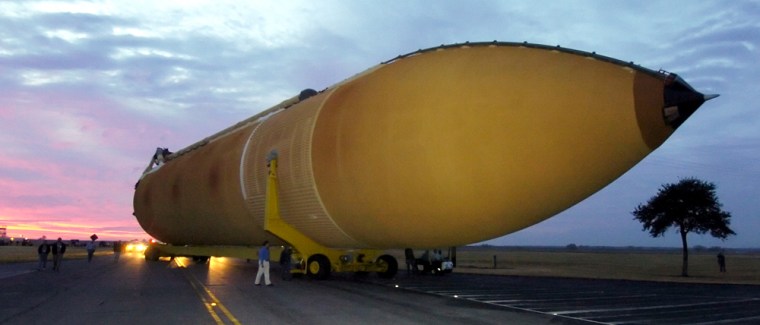NASA’s redesigned fuel tank, a massive vessel that supplies propellant for the launch of the space shuttle, began its five-day trip across the Gulf of Mexico to the launch site on Florida’s east coast.
NASA workers in New Orleans rolled the massive tank onto a 200-foot barge on Friday for the trip down the Mississippi River and into the Gulf of Mexico. The tank will travel around the Florida Keys and up the Banana River and arrive next week at the Kennedy Space Center at Cape Canaveral, Fla. A Coast Guard patrol boat will escort the barge.
The tank “feels like our baby. We have pampered it, and everyone takes great pride in it,” said Sandy Coleman, NASA’s external tank project manager.
The design of the shuttle’s external tank was altered after an investigation blamed the February 2003 Columbia disaster on a chunk of foam that flew off the tank and struck a wing on the shuttle, causing it to break apart over Texas.
NASA officials have called the redesigned tank the safest ever. It underwent a meticulous final inspection Thursday, as workers with the space agency and contractor Lockheed Martin scrutinized it for imperfections in the foam, Coleman said.
“It’s amazing how carefully they look at every inch. We have eyes, triple eyes, on every part of the tank,” Coleman said.
NASA plans to use the tank for a May or June launch of space shuttle Discovery. The shuttle fleet has been grounded since the Columbia accident as NASA scrambled to make changes in hardware, procedures and personnel to comply with recommendations from the Columbia Accident Investigation Board.
Fixing the external tank was a key part of the shuttle program’s return to space, officials said.
The 154-foot tank holds the liquid hydrogen and oxygen — the propellants for the shuttle’s main rocket engines during launch. The supercooled chemicals cause the formation of ice on the outside of the tank as the shuttle is prepared for launch.
Insulation, applied as a foam, reduces the amount of ice. But investigators believe it was chunks of foam insulation that peeled off the external tank during launch that led to the destruction of Columbia. The debris ripped a hole in the left wing of the space shuttle.
On Feb. 1, 2003, as the spacecraft re-entered the Earth’s atmosphere, superheated gas penetrated the wing through the hole and melted metal struts. The craft shattered, showering east Texas with flaming debris. All seven astronauts were killed.
The redesign of the tank includes new ways of applying the foam insulation, the addition of heaters at key points to prevent the formation of ice before launch and adding cameras that can monitor the outside of the tank during launch.
